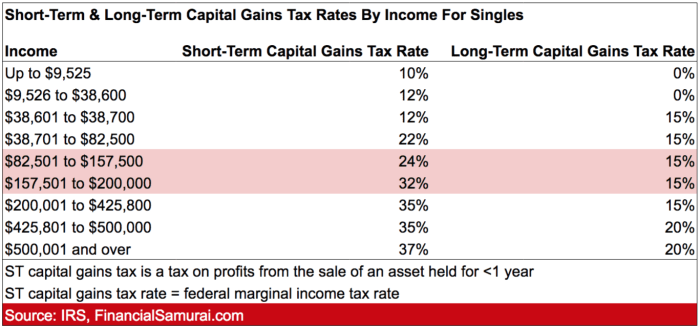Get ready to dive into the world of Capital gains tax rates, where the financial game is strong and the stakes are high. From understanding the basics to exploring advanced strategies, this topic is sure to keep you on your toes.
Whether you’re a seasoned investor or just starting out, this guide will equip you with the knowledge needed to navigate the complexities of capital gains tax rates with confidence.
Overview of Capital Gains Tax Rates
When it comes to capital gains tax rates, it’s all about the taxes you pay on the profits from selling certain assets. These rates can vary depending on how long you’ve held the asset and your income level.
Types of Capital Gains and Taxation
- Short-term Capital Gains: These are profits from selling assets held for one year or less and are taxed at ordinary income tax rates.
- Long-term Capital Gains: Profits from assets held for more than one year are taxed at lower rates, usually ranging from 0% to 20%.
- Real Estate Capital Gains: Gains from selling property can also be subject to capital gains tax, depending on the duration of ownership.
Impact of Capital Gains Tax Rates
- Investment Decisions: Capital gains tax rates can influence how investors choose to buy, sell, or hold onto assets. Lower rates may encourage more investment activity.
- Financial Planning: Understanding the tax implications of capital gains can help individuals make strategic decisions about their investment portfolios and overall financial goals.
- Economic Growth: Changes in capital gains tax rates can impact the overall economy by influencing investment behavior and capital allocation.
Types of Capital Gains
When it comes to capital gains, there are two main types to consider: short-term and long-term capital gains. These two types are taxed differently based on the holding period of the asset.
Short-Term Capital Gains
Short-term capital gains are profits made from the sale of assets that were held for one year or less. These gains are typically taxed at the individual’s ordinary income tax rate, which can range from 10% to 37%. Examples of assets that fall under short-term capital gains include stocks, bonds, and mutual funds.
Long-Term Capital Gains
On the other hand, long-term capital gains are profits made from the sale of assets that were held for more than one year. These gains are taxed at a lower rate than short-term gains, ranging from 0% to 20%, depending on the individual’s income level. Examples of assets that fall under long-term capital gains include real estate, precious metals, and collectibles.
Capital Gains Tax Rates Comparison

When comparing current capital gains tax rates with historical rates, it is essential to analyze how changes in these rates impact investment strategies and the overall economy.
Current vs Historical Rates
- Historically, capital gains tax rates have fluctuated, with some periods seeing higher rates than others.
- Current capital gains tax rates are generally lower compared to rates in the past, which can incentivize investors to take more risks and invest in the stock market.
- Lower tax rates on capital gains can lead to increased investment activity, as investors seek to take advantage of potential profits without being heavily taxed.
Impact on Investment Strategies
- Changes in capital gains tax rates can influence how investors allocate their assets and make investment decisions.
- Higher tax rates may discourage investors from realizing gains, leading to a potential decrease in trading volume and liquidity in the market.
- Lower tax rates, on the other hand, can spur more active trading and investment, as investors look to maximize their after-tax returns.
Economic Impact
- Varying capital gains tax rates can have a significant impact on the overall economy, affecting consumer spending, business investment, and economic growth.
- Higher tax rates may reduce the incentive for individuals to invest in the market, potentially slowing down economic activity.
- Conversely, lower tax rates can stimulate investment, leading to increased economic growth and job creation.
Strategies to Minimize Capital Gains Taxes
When it comes to reducing capital gains tax liabilities, there are various tax planning strategies that can be implemented. These strategies aim to help investors optimize their tax outcomes and keep more of their investment gains in their pockets. Two common techniques used to minimize capital gains taxes include tax-loss harvesting and utilizing tax-deferred accounts.
Tax-Loss Harvesting
Tax-loss harvesting involves selling investments that have experienced a loss in order to offset capital gains taxes on profitable investments. By strategically realizing losses, investors can reduce their overall tax liability. It is important to note that there are rules and limitations surrounding tax-loss harvesting, so consulting with a financial advisor or tax professional is recommended to ensure compliance with tax regulations.
Tax-Deferred Accounts
Investors can also minimize capital gains taxes by utilizing tax-deferred accounts such as Individual Retirement Accounts (IRAs) or 401(k) plans. Contributions made to these accounts are typically tax-deductible, and investment gains within the account grow tax-deferred until withdrawals are made in retirement. This allows investors to delay paying taxes on their gains, potentially lowering their current tax burden.
Importance of Timing
Timing plays a crucial role in minimizing capital gains taxes. By strategically selling assets at the right time, investors can optimize their tax outcomes. For example, holding investments for more than a year may qualify for lower long-term capital gains tax rates compared to short-term gains. Additionally, selling investments during years when overall income is lower can help reduce the tax impact of capital gains.
